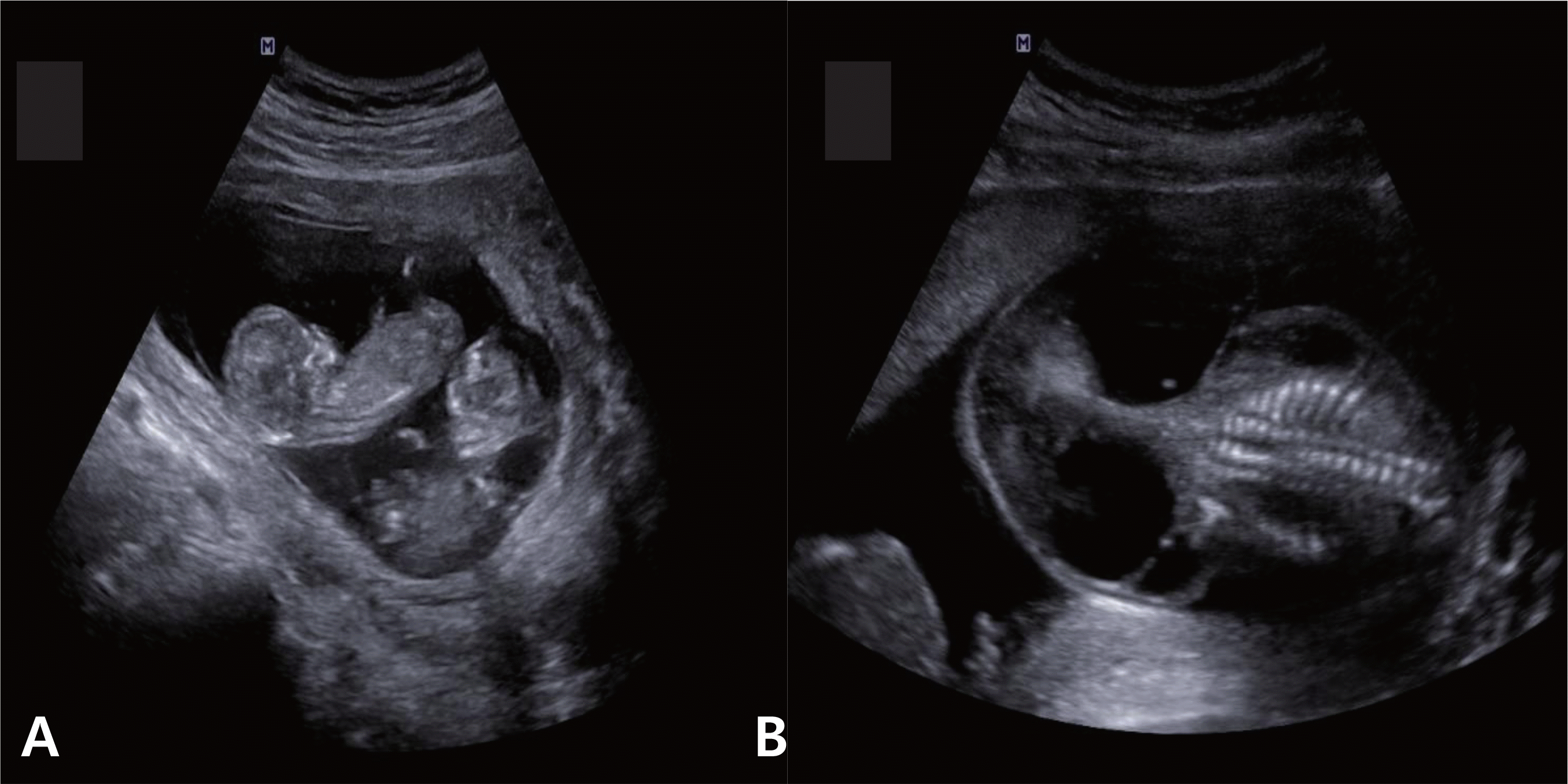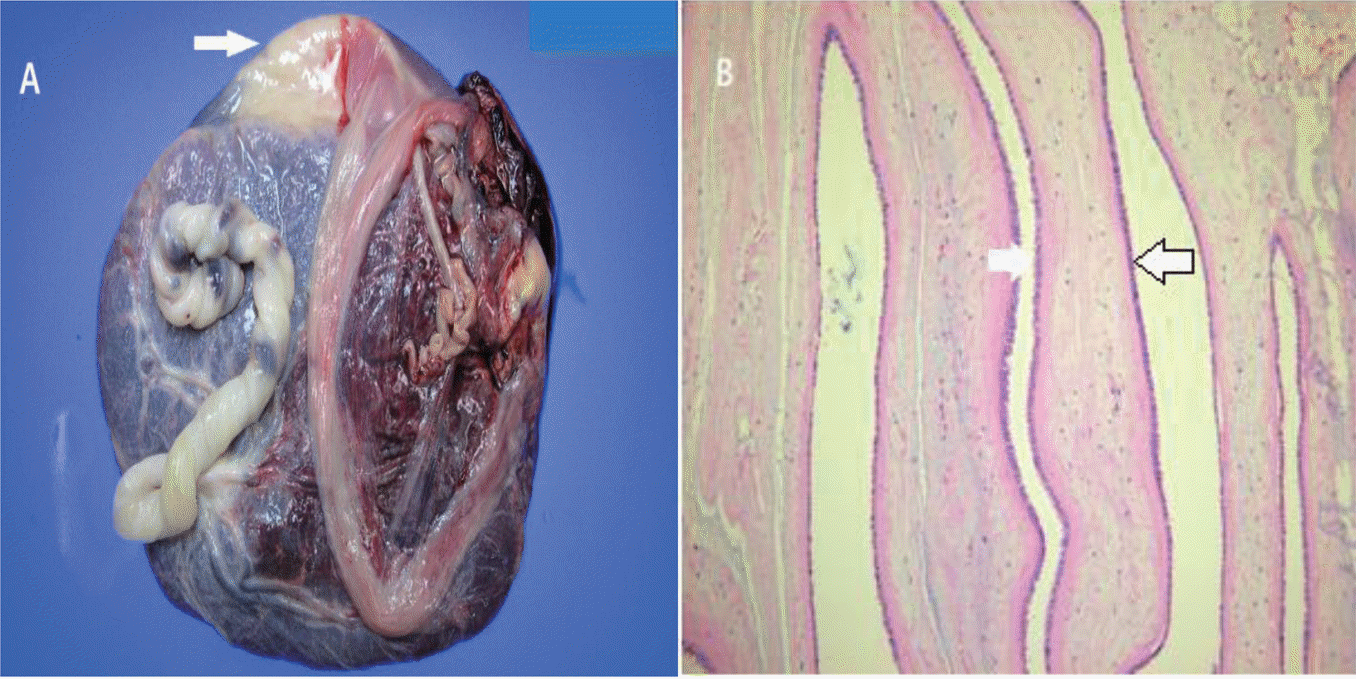Abstract
Monochorionic twins with discordant karyotypes are rare and mostly caused by post-zygotic mitotic nondisjunction. A 32 year old nulliparous woman at 11 weeks of gestation with spontaneous twin pregnancy was referred to our hospital. An amniocentesis was performed in both amniotic sacs at 15 weeks of pregnancy. One fetus in monochorionic twin pregnancy was diagnosed with Turner syndrome with cystic hygroma, and the other fetus was normal. Because of high mortality rate in abnormal fetuses, the umbilical cord coagulation was performed using radiofrequency ablation to prevent the damage of co-twin that may be caused by the demise of one fetus. After delivery, chorionicity of placenta was ascertained by pathologic exam. Postnatal findings of physical exam, abdominal and brain sonography were normal in the surviving neonate.
Go to : 
REFERENCES
1.Asztalos E., Barrett JF., Lacy M., Luther M. Evaluating 2 year outcome in twins < or = 30 weeks gestation at birth: a regional perinatal unit's experience. Twin Res. 2001. 4:431–8.
2.Mastroiacovo P., Castilla EE., Arpino C., Botting B., Cocchi G., Goujard J, et al. Congenital malformations in twins: an international study. Am J Med Genet. 1999. 83:117–24.

3.Paramasivam G., Wimalasundera R., Wiechec M., Zhang E., Saeed F., Kumar S. Radiofrequency ablation for selective reduction in complex monochorionic pregnancies. BJOG. 2010. 117:1294–8.

4.Machin GA. Some causes of genotypic and phenotypic discordance in monozygotic twin pairs. Am J Med Genet. 1996. 61:216–28.

5.Keith L., Machin G. Zygosity testing. Current status and evolving issues. J Reprod Med. 1997. 42:699–707.
7.Machin G. Non-identical monozygotic twins, intermediate twin types, zygosity testing, and the non-random nature of monozygotic twinning: a review. Am J Med Genet C Semin Med Genet. 2009. 151C:110–27.

8.Bohec C1. Douet-Guilbert N., Basinko A., Le Bris MJ., Marcorelles P., Audrézet MP, et al. Difficult diagnosis and management of an heterokaryotypic monochorionic twin pregnancy with discordant fetal sex and 45,X/47,XYY karyotypes. Fetal Pediatr Pathol. 2010. 29:424–30.
9.Lewi L1. Blickstein I., Van Schoubroeck D., Gloning KP., Casteels M., Brandenburg H, et al. Diagnosis and management of heterokaryotypic monochorionic twins. Am J Med Genet A. 2006. 140:272–5.
10.Schmid O., Trautmann U., Ashour H., Ulmer R., Pfeiffer RA., Beinder E. Prenatal diagnosis of heterokaryotypic mosaic twins discordant for fetal sex. Prenat Diagn. 2000. 20:999–1003.

11.Malone FD., Ball RH., Nyberg DA., Comstock CH., Saade GR., Berkowitz RL, et al. First-trimester septated cystic hygroma: prevalence, natural history, and pediatric outcome. Obstet Gynecol. 2005. 106:288–94.

12.Hillman SC., Morris RK., Kilby MD. Co-twin prognosis after single fetal death: a systematic review and meta-analysis. Obstet Gynecol. 2011. 118:928–40.
13.Pasquini L., Pontello V., Kumar S. Intracardiac injection of potassium chloride as method for feticide: experience from a single UK tertiary centre. BJOG. 2008. 115:528–31.

14.Nobili E., Paramasivam G., Kumar S. Outcome following selective fetal reduction in monochorionic and dichorionic twin pregnancies discordant for structural, chromosomal and genetic disorders. Aust N Z J Obstet Gynaecol. 2013. 53:114–8.

15.Shevell T., Malone FD., Weintraub J., Thaker HM., D'alton ME. Radiofrequency ablation in a monochorionic twin discordant for fetal anomalies. Am J Obstet Gynecol. 2004. 190:575–6.

16.Bebbington MW., Danzer E., Moldenhauer J., Khalek N., Johnson MP. Radiofrequency ablation vs bipolar umbilical cord coagulation in the management of complicated monochorionic pregnancies. Ultrasound Obstet Gynecol. 2012.
Go to : 




 PDF
PDF ePub
ePub Citation
Citation Print
Print




 XML Download
XML Download